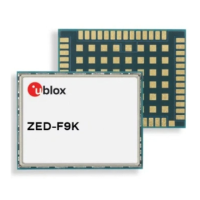ZED-F9K-Integration manual
permanently. Another type of interference can be caused by noise generated at the PIO pins that
emits from unshielded I/O lines. Receiver performance may be degraded when this noise is coupled
into the GNSS antenna.
EMI protection measures are particularly useful when RF emitting devices are placed next to the
GNSS receiver and/or to minimize the risk of EMI degradation due to self-jamming. An adequate
layout with a robust grounding concept is essential in order to protect against EMI.
Intended Use: In order to mitigate any performance degradation of a radio equipment under
EMC disturbance, system integration shall adopt appropriate EMC design practice and not
contain cables over three meters on signal and supply ports.
4.7.1 General notes on interference issues
Received GNSS signal power at the antenna is very low. At the nominal received signal strength (-128
dBm) it is below the thermal noise floor of -111 dBm. Due to this fact, a GNSS receiver is susceptible
to interference from nearby RF sources of any kind. Two cases can be distinguished:
• Out-of-band interference: Typically any kind of wireless communications system (e.g. LTE,
GSM, CDMA, 3G, WLAN, Bluetooth, etc.) may emit its specified maximum transmit power in
close proximity to the GNSS receiving antenna, especially if such a system is integrated with
the GNSS receiver. Even at reasonable antenna selectivity, destructive power levels may reach
the RF input of the GNSS receiver. Also, larger signal interferers may generate intermodulation
products inside the GNSS receiver front-end that fall into the GNSS band and contribute to in-
band interference.
• In-band interference: Although the GNSS band is kept free from intentional RF signal sources
by radio-communications standards, many devices emit RF power into the GNSS band at levels
much higher than the GNSS signal itself. One reason is that the frequency band above 1 GHz
is not well regulated with regards to EMI, and even if permitted, signal levels are much higher
than GNSS signal power. Notably, all types of digital equipment, such as PCs, digital cameras,
LCD screens, etc. tend to emit a broad frequency spectrum up to several GHz of frequency. Also
wireless transmitters may generate spurious emissions that fall into GNSS band.
As an example, GSM uses power levels of up to 2 W (+33 dBm). The absolute maximum power
input at the RF input of the GNSS receiver can be +15 dBm. The GSM specification allows spurious
emissions for GSM transmitters of up to +36 dBm, while the GNSS signal is less than -128
dBm. By simply comparing these numbers it is obvious that interference issues must be seriously
considered in any design of a GNSS receiver. Different design goals may be achieved through
different implementations:
• The primary focus is to prevent damaging the receiver from large input signals. Here the
GNSS performance under interference conditions is not important and suppression of the
signal is permitted. It is sufficient to just observe the maximum RF power ratings of all of the
components in the RF input path.
• GNSS performance must be guaranteed even under interference conditions. In such a case,
not only the maximum power ratings of the components in the receiver RF path must be
observed. Further, non-linear effects like gain compression, NF degradation (desensitization)
and intermodulation must be analyzed.
Pulsed interference with a low-duty cycle such as GSM may be destructive due to the high
peak power levels.
4.7.2 In-band interference mitigation
With in-band interference, the signal frequency is very close to the GNSS frequency. Such
interference signals are typically caused by harmonics from displays, micro-controller operation, bus
systems, etc. Measures against in-band interference include:
UBX-20046189 - R01
4 Design Page 83 of 105
C1-Public Early production information

